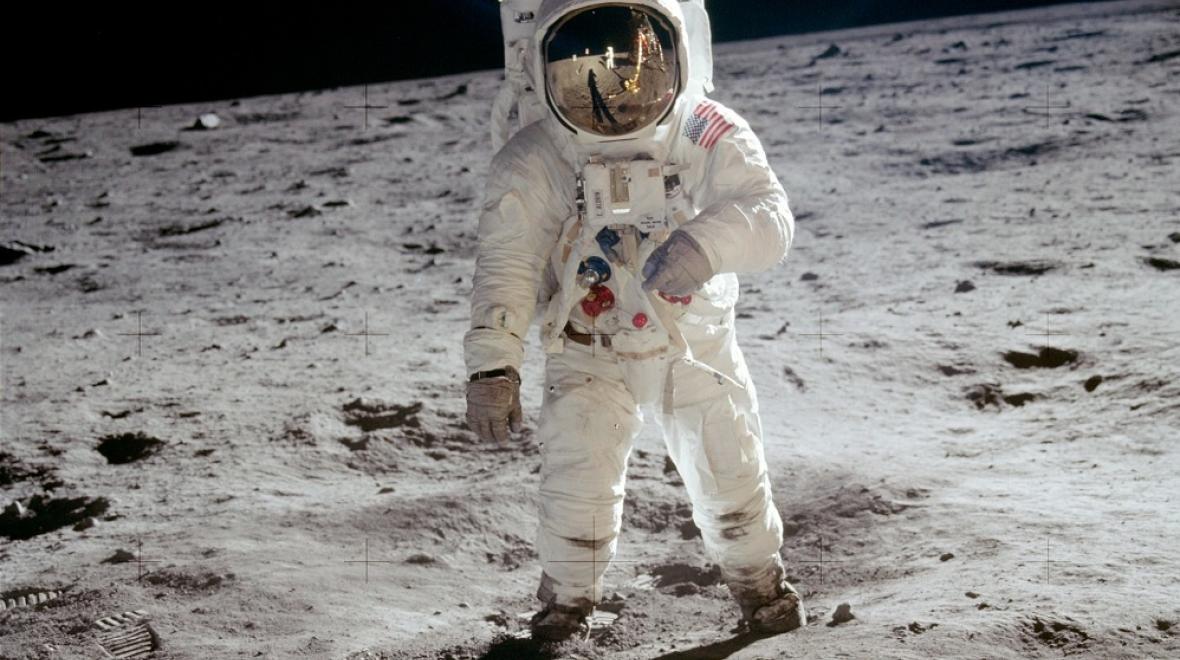
Photo:
Astronaut Buzz Aldrin walks on the surface of the moon. Credit: Photo courtesy of NASA
The Saturn V rocket was taller than the Statue of Liberty and weighed as much as 400 elephants. Neil Armstrong carried remnants of the 1903 Wright airplane with him on his lunar voyage. As Walter Cronkite was covering the July 20, 1969 moon landing for CBS, he initially missed the second part of Neil Armstrong’s iconic statement: “One small step for man, one giant step for mankind.”
Those are just a few of the human and superhuman stories your family will learn with a visit to “Destination Moon: The Apollo 11 Mission,” the Museum of Flight’s fascinating new exhibit in honor of the mission’s 50th anniversary.
Whether your kids are space geeks or not, this exhibit deserves to be high on your summer bucket list. Packed with photos, stories and superb video footage, it features one-of-a-kind artifacts from a traveling Smithsonian exhibit (including the Columbia command module), as well as a new presentation of the Museum of Flight’s top moon-mission-related artifacts.

While the main exhibit isn’t super hands-on, it’s designed with such attention to presentation and immersion — particularly the centerpiece displays around the launch, moon landing and return to Earth — that even the youngest and most uninterested will become caught up in moon madness.
And as for dedicated astro-nuts? Prepare for return voyages.
The exhibit opens with a “Washington Goes to Space” series of displays that documents our state’s influence on the rapidly expanding space industry. My favorite artifact was a Boeing egg-beater (designed when Boeing was considering other lines of work); and a Boeing-designed lunar land rover.
Space race with the Soviet Union
The space-race backstory is well-told with the aid of many photos, as well as artifacts such as Sputnik 1, a duplicate of the world’s first artificial satellite. You can watch JFK’s 1961 speech that proclaimed a goal of landing a man on the moon (and safely returning to Earth) by the end of the decade. Look for a rare SK-1 spacesuit, used in training Vostok cosmonauts.
As you learn about the stages of the space program that led up to Apollo 11, take a moment to read about the tragic story of the Apollo 1 mission, during which three astronauts died in a fire during preflight testing. I appreciated the display of the diverse workforce behind the NASA’s space program, including the now-famous photo of MIT scientist Margaret Hamilton next to stacks of code her team wrote for the Apollo guidance system; an image of Katherine Coleman Goble Johnson, a NASA mathematician who was one of the “human computers” made famous in in the 2016 film “Hidden Figures.”

With black walls, huge movie screens and a wall-encompassing photograph of the lunar landscape, the central part of the exhibit feels dramatic from the start. It opens with a 1969 living room set-up, complete with a Sylvania TV playing Cronkite’s crackling broadcast of the moon landing. Buzz Aldrin’s extravehicular visor and gloves are ingeniously displayed against a famous photo of Aldrin in those very clothes standing on the moon.
Geek out over recovered engine parts from Apollo 12 and 16 (Jeff Bezos funded much of the work to recover and restore such artifacts from the ocean). I was moved by smaller artifacts such as fragments of the 1903 Wright plane that Neil Armstrong brought on his moon voyage, and a command module pilot solo book, which contains instructions and flight plans for Michael Collins, the astronaut left behind on the Columbia while the Eagle landed.

The crown jewel, of course, is the Apollo 11 command module, Columbia, which, at 24 feet long and 12 feet wide, was the only component of the 40-story-tall rocket ship to return to Earth. Ask kids to imagine how three astronauts lived in such cramped quarters; they can explore the spaceship’s compartments through a cool 3-D touch-screen tour.
As you’re looking at Columbia, you can flash to a giant TV screen showing footage of its dramatic landing on the Pacific Ocean, buoyed by giant parachutes.
Six hundred million people watched TV coverage of the moon landing on July 20, 1969. Even if you weren’t alive at the time, it’s hard to not feel nostalgic for such a shared moment of “mission accomplished.” Museum of Flight senior public relations manager Ted Huetter, who was 15 in 1969 and living in Spokane, tells the story of how a few of his “more adventurous” friends hitchhiked all the way to Cape Canaveral to get a glimpse of liftoff; he watched the coverage from his family’s rec room.

Before you leave the exhibit, share your own moon memories — real or imagined — at a computer kiosk near the display of the Columbia.
More lunar fun for kids
When you're through the exhibit, fast-walk past the gift shop and head to the kids’ flight zone, which has been redesigned as Tranquility Base (the site of the moon landing). Kids can make a moon map or a mission patch, sit at Mission Control or the Columbia (which have two-way communication), and learn about Snoopy’s role in the space race; he became part of the space program in 1968.

Over in the Aviation Pavilion, you can pay $8 to go on a well-worth-it virtual-reality experience of landing on the moon, which is super exciting and not too dizzying.
If you go …Where and when: “Destination Moon: The Apollo 11 Mission” is on view at Seattle's Museum of Flight through Sept. 2, 2019. Cost: Entry into the exhibit requires a $10 Destination Moon ticket in addition to regular admission ($25/adult; $21/senior; $16 ages 5–17; kids ages 4 and under free). Museum members pay $5 for Destination Moon tickets. Buy online; the museum is currently selling timed entry tickets. Discounts for AAA members, veterans, active-duty military and Boeing employees. Hours: The Museum of Flight is open daily, 10 a.m.–5 p.m.; the first Thursday of each month, the Museum is open additional hours, from 5–9 p.m., with free admission (there’s still a cost for entry into “Destination Moon”). Family Connections program: Children ages 5–18 can get a free membership at the Museum of Flight if they attend an educational activity. Find out more here. Related events: The Museum of Flight has planned many “Destination Moon” events through the run of the exhibit, including lectures, film screenings and even a musical re-telling of the moon landing during the weekend of the block party (July 19–21). See the museum’s calendar of events, and check the Seattle Summer of Space website for complete list of related events happening around the Seattle this summer. Key events include:
|











